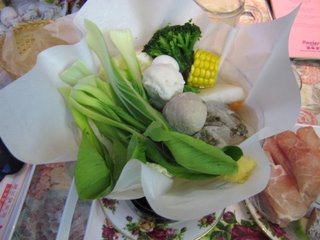A fun and popular daytrip destination, if you're visiting Taipei, is
Dan Shui [dan shuay]. On the MRT (Taipei equivalent of subway), take the red line all the way up until you hit the seaside. The interesting thing is that the red line is above ground all the way to Dan Shui, so you can see the city passing by, from super packed urban to slightly more pastoral suburban. The ride reminds me a lot of Tokyo, actually.
Dan Shui boasts of amazing views of mountains and the sea juxtaposed against each other, peri-colonial architecture and historical sites, and most importantly, FOOD. The small town was first settled by aborigines, then inevitably invaded by a variety of Europeans, ranging from Dutch to Spanish to perhaps Portuguese. The location was very popular with the Europeans because even though the water was shallow, it was where Dan Shui river emptied into the sea, providing a key look out spot and fort location. They left a fort (
Hong Mao Chen, or, fort where the red-haired people hang out) withing walking distance of the now-touristy wharf that is now a museum worth seeing. On the way to Fort Santo Domingo, I passed by a troupe of random teenagers from Minnesota, singing bad Christian pop to some passers-by, in the courtyard of one of the old churches or houses where
George Mackay used to live/work. It's funny that they should choose that deserted area of Dan Shui for their ministry, because it seemed like all the foot traffic was out by the wharf, where the food is, and where pop concerts are often held (the concert du jour was the MRT's promotional 2-day new bands festival).

One of the distinctive things about Dan Shui is that the streets still have an old-timey feel to them, and stores lining each alley sell toys and treats from an era almost forgotten. Note the use of umbrellas as parasols.

Sometimes the food stands come up with innovative ways of selling normal food. The "toilet ice" is one such novelty. Basically, it is soft-serve ice cream in a pink styrofoamy-textured cone that is shaped like a toilet. Notice that it is shaped like the toilets that you stand over, not the western kind on which one sits. I guess the name, "toilet ice" would make little sense to visitors.

The beach is not very appealing, if you're used to the clear blue waters of the Bahamas or something. Dan Shui literally means "shallow water." As you can see, the water really is very shallow, making for a very wet sandbar more than ocean.

Right off of the boardwalk, fishermen sort and count the giant shrimp they just caught. The "fruits de mer" are served right in the restaurants on the other side of the boardwalk.

Steamed crab with a salty broth in the green bowl.

Giant shrimp, seasoned with just salt. Delicious and super fresh (see above photo of fishermen).

A very large scallop with a few chunks of onion. The red-orange part is the egg, I think.

Fish balls in a light broth with green onion.

The notable
Dan Shui A-geh. "A-geh" is actually the Taiwanese pronounciation of it, but I don't think anybody pronounces it in normal Mandarin. It is uniquely made and served in Dan Shui, uniquely Taiwanese. The most basic Dan Shui A-geh is made up of ja yo do fu (or fried tofu), hollowed out and stuffed with mi fun (rice vermicelli). The hole where you stuff it with vermicelli is sealed with a fish paste, which solidifies into a plug very similar to the fish balls once it is steamed. The steamed unit is then served in a sweet and spicy sauce.

Here you can see the fish paste plug, the vermicelli, and the pink sweet-and-spicy plum-based soup in which it is immersed. Like any food in Taiwan, there are a million variations to it. You can have all sorts of fish paste plugs, any sort of flavors of vermicelli, any sort of soup or sauce.

 The bowl of white stuff to the left is 稀飯, and you eat it with the stuff on the plate to the right. Notice the crumbly stuff at the bottom? That is 肉鬆 (dried pork). I felt a little badass eating squid for breakfast...they really know how to make it though. It wasn't tough and chewy at all.
The bowl of white stuff to the left is 稀飯, and you eat it with the stuff on the plate to the right. Notice the crumbly stuff at the bottom? That is 肉鬆 (dried pork). I felt a little badass eating squid for breakfast...they really know how to make it though. It wasn't tough and chewy at all. A few words about the hotel itself. We think it's a family owned business, as some of the staff seem less formal than most hospitality workers in Taiwan. The hotel only has 7-8 floors, 4 rooms per floor. Rates range from 1800 NTD - 3000 NTD (~$56.00-$93.00 USD), depending on how big the room is. Breakfast is from 7am to 10am every morning, and included in the room rate. The hotel is located in the block immediately next to MRT Shuang Lian Station (捷運雙連站), across from Mackay Hospital (馬偕記念醫院) emergency room, making it very convenient for exploring the city and having heart attacks.
A few words about the hotel itself. We think it's a family owned business, as some of the staff seem less formal than most hospitality workers in Taiwan. The hotel only has 7-8 floors, 4 rooms per floor. Rates range from 1800 NTD - 3000 NTD (~$56.00-$93.00 USD), depending on how big the room is. Breakfast is from 7am to 10am every morning, and included in the room rate. The hotel is located in the block immediately next to MRT Shuang Lian Station (捷運雙連站), across from Mackay Hospital (馬偕記念醫院) emergency room, making it very convenient for exploring the city and having heart attacks.









































